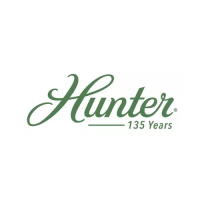nt
r
C
• Sails and Ri
in
12.
Sails & Ri
in
ost sa
ors
e
eve t
at sa
n
s
ar
wor
: a
t
ose
nes
to tend, hal
ards to
ank and sails to lu
. Hunter Marine
has dispelled that m
th once and for all! Innovations b
the crew at Hunter Marine have made sailin
easier, safer
and more com
ortable. The result - much more sailin
un!
Whether
ou are read
to set sail for the islands or
ust
around the buo
s,
our Hunter can reall
make a di
er-
nce. Startin
with the tall, fractional ri
, which is a direct
descendent of the B&R ri
, Hunter has en
ineered the
mast to carr
less wei
ht alo
t with a smaller sections.
This is accomplished b
utilizin
swept-back spread-
rs an
reverse
a
ona
s.
s com
nat
on prov
es
superior stren
th without a backsta
and increases the
stabilit
at the same time. B
usin
a lar
e roach main
as the
ower sail, Hunter has eased the effort in sail
handlin
and allowed
or real versatilit
or all wind and
n
iti
n
Your bene
it: better per
ormance with less e
ort. The
deck la
out reflects the innovation that accompanies the
ri
. An inte
rated arch protects the cockpit from snappin
main sheets and blisterin
sun with the optional bimini.
This arch keeps the cockpit clear and open
WARNING
! !
Refer to Boatin
Safet
, and the Gettin
Underwa
hapters for safe boat handlin
information
If this is
our first boat of this t
pe or
ou are chan
in
to a new boat
ou are not
amiliar with, please ensure
that
ou obtain handlin
and operatin
experience be
ore
assumin
command of the boat. This document is not a
ourse on boatin
sa
et
or seamanship. Your dealer or
national sailin
ederation or
acht club will be pleased
to advise
ou of local sea schools, or competent instruc-
t
r
Never underestimate the potentiall
dan
erous power o
wind, tide and the sea. Alwa
s ensure there is su
icient
trained and pro
icient crew on board to handle the boat
an
ts operat
n
s
stems even
n a
verse con
t
ons.
NOTE: Standing rigging will stretch slightly when initially
loaded. Therefore, the rigging may have to be further tensioned
slightly after a few sails in a strong breeze to compensate for
this initial stretch. Once the mast is tuned and initial stretch is
taken out, the rig should need retuning only at the beginning of
each season.
12.1 Main Ri
Components
Anodized B&R Ri
Mas
B
m
ual Sin
le Line Reefin
S
stem
standard mast onl
elf tackin
/ or overlappin
Jib S
stem
Inboard Jib Track w
Ad
ustable
ars
option
Internal Hal
ards led to Cockpit
ib Furlin
S
stem
Lar
e Roach Mainsail w
Flakin
stem
standard
mast
n
t
n
r
el
-Tailin
Jib Winches w
Handles
elf-Tailin
Ri
in
Winches w/Handles
Line Stoppers &
r
anizers
ver the course of the next few pa
es we will outline
some of the components featured here, alon
with some
the optional components o
our sails and ri
in
aboard
our Hunter sailboat.
12.2 The Mas
Your main and most vital ri
component is the mast. It
arr
es t
e sa
s an
s supporte
t
e stan
n
r
n
Your Hunter features the B&R ri
; a desi
n b
Lars
Ber
strom and Sven Ridder. The desi
n was born in
the 7
’s and has been used on ocean racers as well as
world cruisers producin
tremendous success. The B&R
r
s
es
ne
to e
m
nate
a
sta
,
ac
sta
s, an
runnin
backsta
s. The 30-de
ree sweptback spreaders
and reverse dia
onals support the mast sidewa
s, fore,
and aft and the shrouds are discontinuous. Wei
ht is
minimized and usin
a smaller mast section maximizes
airflow to the main. The an
les between the shrouds and
foresta
equal an even 120-de
ree trian
le that evenl
spreads the load o
the mast. The in
ormation in the
ol-
lowin
describes the basic functions of each standin
r
n
Ca
shrouds
V1-V3, D4
Sta
the mast a
ains
lateral
athwartship
loads. Attached near the masthea
n a masthead ri
, and at
oresta
level on a
ractional
ri
. The cap shrouds are led via spreaders to the boat
s
a
n
ates.
ntermediate shrouds
D2-D3
Fitted on multiplespread-
r ri
s, and attached in the area of the upper
spreaders. Fitted with links in the lower spreader tips

